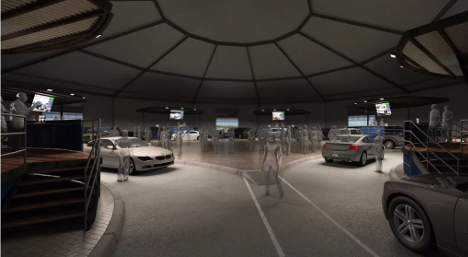New patent could change shape of auto auction arenas

Screenshot from autoauctionintheround.com. Full images available on website.
If there is a groundswell of momentum for Bob Wolfsen’s Auto Auction In The Round concept — which has earned a patent from the United States government — auctions could physically look much differently than they do today.
Walk into most auto auctions today and the arena where the sales happen has a familiar appearance: rectangular with long lanes that extend from one side to the other.
Wolfsen’s design shakes that up, making the arena — as the name would imply — round.
Each selling arena in Wolfsen’s design is a circular pod that includes anywhere from eight to 12 lanes, he said in a recent interview with Auto Remarketing.
The vehicles enter and exit behind each auction block. They come into the pod, go around to the front of the block, going 180 degrees before exiting out behind the block.
To get to the pods, attendees can walk from the office down a “tube” hallway and then select one of the pods to enter, he explained.
The patent was approved on March 23, Auto Auction In The Round is now operational and the official patent number is 9,691,100.
Inspiration for idea
Wolfsen, whose company is based Chandler, Ariz., is the transportation manager at Metro Auto Auction in Phoenix.
Asked what prompted the idea, he said: “It started when I helped put another auction together here in Phoenix — Dealers (Auto Auction of the Southwest),” he said.
Wolfsen and the team there shaped the auction blocks into a V-shape, he said, “so that the dealers could see all the cars at all the blocks from any position.
“I wish I could take credit for that but I can’t,” he said. “But it started me thinking about, ‘How do I close the V to make a circular pattern?’”
But closing the V would result in bunched-up traffic, he said: “It would be six lanes feeding into a three-lane area. So that’s when I started thinking about the circle, and coming in from the outside of the circle, around the front of the blocks, and then back out behind the block.
“And I actually laid it out over there — this was, gosh, almost 14 years ago now — in paper and drawing it out on the floor. It was an empty building. It made sense. So that started the thought process”
The design was based on what dealers had told him over the years.
“And it boils down to, ‘I missed some opportunities. I wish I had the ability to be in that other lane at a point because I really needed that car,’” Wolfsen said. “I hear this more and more. I hear it every week here. On the seller’s side, (they’re) never happy with the lanes. ‘Oh it’s too far away from the door. It’s too close to the end of the building.’
“There’s always a reason. And the third item is that, ‘I’m not happy with my numbers. I want to run in prime time and I want to run in the meat of the sale, and I want to run in 30 to 60,’ or whatever that might be,” he continued. “This addresses all those issues, where the buyer will be in a position where he can bid on any car that comes through the building.
“That’s unheard of in this industry. Where the seller can (choose to) not be concerned about lane preference, because it doesn’t matter anymore. Every car has the same exposure, availability.”
When it comes to “good numbers” to get on sale day, Wolfsen believes the new design can change that as well, based on what he expects will be a shift in the “attendance curve” typical for an auction.
Usually, Wolfsen said, dealers might arrive at the auction, get everything done within an hour or so and then leave.
He argues that the new design, by giving dealers continued exposure to inventory throughout the sale, will entice dealers to stay longer.
Wolfsen also said he believes the design will lead to a significant reduction in accidents, “because we’re taking the majority of the traffic away from them” by moving the vehicles in behind the blocks, circling in the blocks and exiting.
“They won’t have that what I affectionately refer to as ‘running across the freeway’ — cars running north to south, dealers going back and forth, east to west,” he said. “And your liability there is certainly extensive in that type of environment.”
He estimates that new system is likely to cut around 90 percent of situations where someone can be injured
What is next?
As far as what the next steps are, Wolfsen said there are three options he is considering.
One is to sell patent license agreements to other parties to build the facilities, with the stipulation that no others are built in that specific market. It would be protected territory, he said.
Another is to look for financial backers and construct the facilities himself.
Lastly, there is the option to sell the patent outright. Which he does not favor, as he wants to stay involved in the process.

 View The Latest Edition
View The Latest Edition

